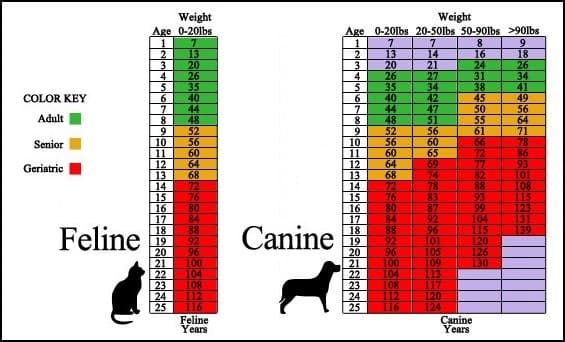Factors affecting nutrition:
Optimum Nutrition is a key element in raising a healthy dog or cat. Some of the many factors affecting pet nutritional requirements include:
1. Breed
2. Age
3. Gender
- Intact
- Spayed or Neutered
4. Physiological State
- Growth
- Adult
- Pregnancy
- Lactation
- Senior
- Geriatric
5. Body weight & composition
6. Activity level / Environment
- Show Dogs
- Guard Dogs
- Agility Dogs
- Working Dogs
- Hunting Dogs
- Racing Dogs
7. Stress
8. Health status
Breed
In general, pet food companies provide energy needs that are based primarily on body weight. Yet, we know that some breeds of similar size and weight can differ greatly in energy needs. For example, a Newfoundland has an energy requirement that is 20% below average while Great Danes can be up to 60% above average. There are a number of breeds that have a higher ratio of body fat to lean muscle mass like Beagles and Labrador Retrievers. Fat tissue is metabolically less active than muscle causing these breeds to have a below-average energy requirement for their body weight. For highly muscled breeds we should expect the opposite. It is important that food amounts are adjusted based on specific breed requirements not just their weight.

This information has prompted some pet food manufacturers to create what they call Breed Specific Diets. Let’s take the Hounds as an example. Can anyone believe that what is optimum for the Bassett Hound is also best for a Greyhound?
Age
Not all breeds mature at the same rate. Knowing when an animal is growing and when it actually becomes a senior citizen is important in determining the nutritional needs capable of maintaining a healthy pet.

Relative Age of Pets in Human Years

Gender
Males usually have a greater amount of muscle mass than their female counterparts. This means they expend more energy per pound of body weight and have a lesser tendency to become overweight or obese.

A gender issue that is important to mention is the choice an owner makes to keep a pet intact or to spay or neuter. Spaying or neutering a pet may lead to its gaining weight; but, only if you overfeed it. The loss of sexual hormones will usually cause an animal to reduce its activity level, as it no longer has a need to seek out a mate. This natural slowing in activity must be met with an increase in energy output (walks, play etc.) or a reduction in energy intake (cutting back on the diet) if you want to maintain a healthy weight and avoid health issues resulting from obesity.
Physiological Stage

Body Weight & Composition
Body weight (mass) is the primary factor used in determining the base level of energy required by any animal. Scientists have developed mathematical formulas that are fairly accurate in calculating the number of calories (fuel) that we should be feeding for the average pet weight. It should be noted that base energy levels must constantly be adjusted based on all the other factors that determine the optimum level of nutrition an animal needs at any given time, period or condition in its life.

Activity Level
Next to weight, activity is the second most important factor in determining dietary needs for a healthy pet. Often the lifestyle of the pet owner determines the activity level of their pet. The number of overweight dogs and cats today indicates that too few of us are adequately exercising our best friends resulting in dog health problems that could be avoided.

When exceeding routine exercise, energy needs can rise rapidly. Police and military working dogs may not look like they are expending a lot of energy when on routine patrol, but the level of alertness (sight, movement and smell) all burn up calories at a high rate.
Many of our performance, herding and hunting breeds spend countless hours a day expending energy just to satisfy breed instincts, please their owners, and do what they truly enjoy most.
Performance Athletes
Can you imagine our human athletes, Olympic contenders and weekend warriors consuming a diet that consists of inferior food sources in the wrong balance and highly processed ever being capable of delivering a winning performance? Would this kind of diet provide the required strength, stamina and endurance needed to compete under stress and to their best ability?
If you believe this to be true then apply this same rational to our canine athletes. A popular subject in any dog sport or competition is comparing and trying new dog foods and supplements hoping to find the magic formula that will provide winning results.
We need to recognize that canine athletes are different than us. Carnivores depend on proteins and fats for energy and life-sustaining nutrients. The more energy a dog expends, the more fat and protein are required in their system. If these energy-feeding factors are not found in the system, the dog quickly loses the ability to sustain endurance and stamina.

The main diet available for dogs today is dry dog food full of carbohydrate. Carbohydrates are not good energy producers for canines. Carbohydrate contains starchy and high fiber compounds that take longer to digest in the dog’s short and simple digestive tract, compared to the ease of digesting fresh foods (animal proteins and fats). Digestion requires lots of energy so the less time spent with digestion; the more energy is available elsewhere, like the field or the ring.
Current research points to several factors that help achieve endurance and stamina in dogs. Increasing protein allows for glycogenesis, which is the ability to make glucose from amino acids. Added protein in the athlete can assist in repairing injuries, preventing performance anemia and improving performance. An example of performance enhancement includes greyhounds that ran an average of 0.2 seconds faster, the difference in winning or losing a race, when trained on higher protein and lower carbohydrate diets.
One benefit of feeding a biologically appropriate natural diet of 55% protein is it not only provides these added benefits it also insures that cellular turnover, and other basic body functions are maintained at high levels.
Endurance dogs require extra fat which is highly digestible and helps keep energy levels stable, unlike carbohydrates. For some endurance tasks like the Iditarod Sled Dog Race, the fat content of the diet may be 50% or more. Fat increases overall energy intake with less volume due to its density and palatability. In addition, high-fat diets fed during training help to alter a dog’s metabolism so that it is better able to utilize fat during competition.
Another thing to consider in training and competing with our performance dogs is the amount of water loss from increased respiration. Depending on the dog’s exercise intensity, and environmental temperature and humidity, evaporative water losses may increase 10-20-fold during exercise. When the air is cold it has very little moisture in it. When the cold air reaches the dogs lungs, the air becomes saturated with water so that about 6% of every exhaled breath is water. In warm, humid climates the inhaled air is already saturated with water and so the dog loses less water from the lungs with each breath. However, because dogs pant to cool themselves, water loss through evaporation and excess saliva often leads to evaporative losses equal to or in excess of those in cold environments.

“No lower limit or minimal requirement for carbohydrate has been established in the dogs. Ketosis and associated sodium depletion occur in humans when suddenly shifted to a low-carbohydrate diets. Dogs are much more resistant than humans to ketosis when fasted and fed 100% fat. Sled dogs fed a high fat (66% energy) and zero carbohydrate diet at twice maintenance showed very low blood levels of acetoacetate and beta-hydroxybutyrate at 3 and 9 weeks. There is no evidence that dogs have an essential nutrient requirement for glucose, using nutrient in the strict sense of something assimilated from the diet. Tissue utilization of glucose accounts for about 25% of the total resting metabolism in dogs and other animals. Clearly, this can be synthesized from nutrient precursors of glucose, (e.g. amino acids and glycerol, in dogs fed zero carbohydrate).”
The list of activities we are able to share with a healthy pet is constantly growing. Dogs have been bred to hunt, retrieve, race and to compete in obedience and conformation. Working dogs pull, guard, seek and rescue. Canine athletes participate in spectacular events that show off their unique ability to be trained to do most anything. As performance varies so do their nutritional needs.
The performance trophy goes to the sled dog. Imagine, if you can, a 45 pound Siberian Husky that is about to begin the Iditarod Sled Dog Race, which involves running over a hundred miles a day for 10 days in temperatures that chill both the mind and spirit of man and animal. To meet this dog’s energy needs with a commercially prepared premium dog food one would need to feed 5-7 pounds of food a day. In comparison this would be equal to a 170-pound marathon runner having to consume 30 pounds of food just before embarking on a 26 mile run. To accomplish meeting such needs without putting the sled dog into unbelievable gastric pain| mushers have reversed the role of traditional feeding. They build their racing diet from highly concentrated protein and fat sources and the addition of a lot of nutrient dense supplements – occasionally adding a little kibble to satisfy endorsement contracts. Having worked with performance dog owners over the years, I can say this with certainty|in order to achieve optimum performance, you must supplement all commercially prepared diets.
Stress
It is sometimes hard for us to consider that the well-groomed dog sleeping on the couch is really under any level of increased stress. Most likely it isn’t. What is stress? How does it affect our pets, how do they react to stress and what dog health issues can be associated with it? Here are the answers.
Stress is a general set of responses to any extra demand either physical or emotional. Early physiological responses are an increased heart rate, stomach constriction, and energy or fuel mobilization. Stress causes adrenalin to be released dilating pupils and readying an animal for “Fight or Flight”. Protein stores are rapidly converted to glucose causing blood sugar levels to rise and protein reserves to become depleted. As protein reserves deplete, blood cell numbers and antibody production diminish. Over time, stress suppresses normal immune function thereby increasing susceptibility to infectious agents, cancer challenges and other pet health problems.
Physical signs of good stress are enhanced physical condition and performance while signs of bad stress include diminished activity, poor performance, dehydration, weight loss, anemia, disease and slowed recovery.

The psychological signs of stress are many. At low levels (good stress) alertness, attitude and responsiveness is usually enhanced. At high levels (bad stress) we see maladjustment, dissociation, irritability, depression, apathy, unsocial behavior and a reluctance to eat and drink.
The sources of stress are many and if more than one is present they have an accumulative effect. The type of stress and the length of time it is present determines how detrimental the overall effect will be. Puppies and kittens experience the stress of separation during weaning when mom pushes them away and again a few weeks later when suddenly they are being shipped off to a new home away from their siblings and playmates. This is probably the most severe stress an animal may ever experience and it comes at a time when the immune system has not fully developed leaving even a healthy pet exposed to infections, parasites and disease.
Training, work and performance all have stress components to them, which are compounded by the amount of work required and the environmental situation that is present, i.e. hot or cold temperatures, high humidity, length of training, degree of work, level of noise and confinement.
Finally, every single pathological condition (disease, trauma, injury) has a component of stress that unless controlled will exacerbate the condition and delay healing.
Stress, in effect, causes an animal system to work harder. This increased output creates an increased need in nutritional requirements. When stress is allowed to persist, pet nutrition needs continue to increase while the usual animal response is to desire less food. This creates what I call “The Nutritional Stress Gap”.
If levels of bad stress (distress) are allowed to persist, the nutritional stress gap widens. This can present a serious problem to any pet owner who may not recognize the signs or effects of stress.
One of the first consequences of high or prolonged stress is an increased demand for protein of high biological value (high essential amino acid content). During stress, protein reserves are rapidly depleted requiring steady replacement to prevent the breakdown of body tissues. Numerous studies have demonstrated that stress is directly linked to anemia. Without constant fresh sources of high quality protein, the replacement of blood cells and other critical tissues is often compromised.
During stress, many vitamins and minerals are rapidly depleted. Calcium, phosphorus, Potassium, Magnesium, Copper and Zinc are excreted in the urine. Blood levels of Iron, Copper and Zinc and the vitamins (A, E and C) are markedly decreased and the normal synthesis of vitamin K in the gut is suppressed.
I have been highly successful in overcoming the nutritional effects of stress by replacing the nutrients lost through reduced food intake with highly concentrated, completely balanced pet supplementation. With a little training, you can lessen the health problems associated with stress by anticipating it and providing higher levels of protein and other essential nutrients prior to work, performance or surgery and throughout any and all other stressful events or stressful periods in an animal’s life. The result will be a happy, nutritionally satisfied pet.














0 Comments